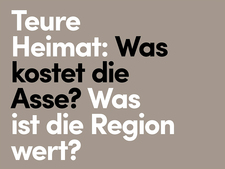Insights into the Asse Mine issue on the topic "money"
Expensive homeland: What does the Asse mine cost? What is the region worth?
In this issue the BfS makes a taboo the subject of discussion – money. Operation and decommissioning of the Asse II mine cost 300,000 euros daily. It cannot be taken for granted that many millions of tax payers' money are made available for a project over many years. Therefore the BfS lays open what the Asse mine costs, what the money is used for and whether the remediation of a relic also provides benefits for the region.
Not everybody wants to talk money when discussing the Asse mine, nor do they want to hear how much the remediation of the relic will cost. Those who talk about costs may also be confronted with doubts. Insofar as the volume of expenditures is concerned, the question is often asked: Do we really want to spent over 300,000 euros every day? Does it mean that much to us?
"Safety must come before economic interests"

![]() Since 1901 the Bismarck Tower has marked the Asse mountain
Since 1901 the Bismarck Tower has marked the Asse mountain
The new task of the Insights into the Asse Mine consciously deals with the issue of money. Even if, in view of the environmental risks, it is often said: Money is not an issue. "I always wondered about this statement in the context of the Asse mine,"
says Wolfram König, President of the Federal Office for Radiation Protection. "Correct is: Safety must come before economic interests. However, money is definitely an issue for us as a public institution. We are legally obliged to responsibly handle taxpayers' money and must again and again legitimise our actions by social and political decisions,
" König said in the interview published in the Insights into the Asse Mine.
Investments into the region
In a report the journalist Lutz Meier offers new perspectives on costs: For many people the nuclear waste in the Asse mine is a great burden associated with high costs. At the same time, the hope for a better future is growing with money from the Future Funds. And, what is frequently overlooked: Via staff costs and taxes the region will benefit from a portion of the expenditures.
Insight into the account books
In the Asse project money is no secret. Did you know, for example, that the power costs for the Asse mine alone amount to over 2 million euros annually? Readers will learn in this issue not only how much the Asse mine has been worth to us so far. Charts show for which concrete items money was spent in 2014 and thus clarify the dimensions of one of the biggest environmental projects in Germany.


